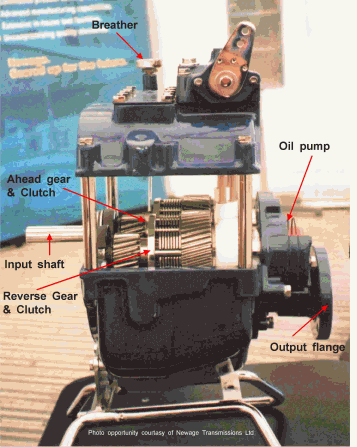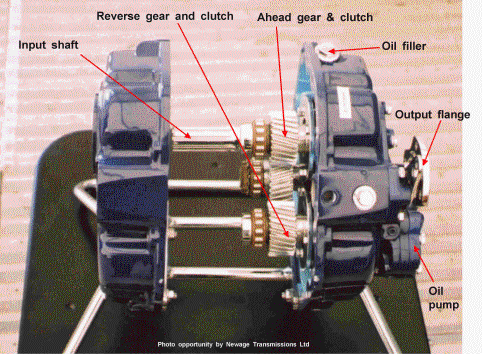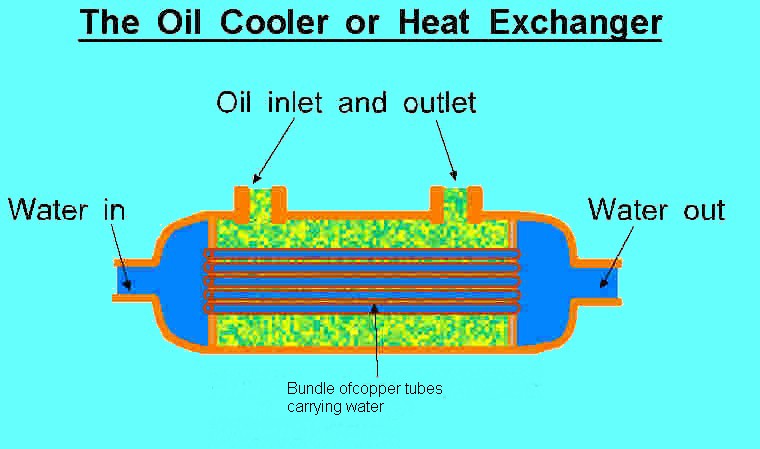Home Index
On
| Back | Home Index |
On |
The purpose of the gearbox is to provide a neutral, ahead and astern gear. Since modern engines tend to produce their power at revs which make propellers inefficient it is likely that the gearbox will also include a reduction gear.
Reduction gears
Reduction gears may be mounted on the back of the gearbox and require separate oil filling and draining, if they do it is likely that they require different oil to the gearbox. Lister reduction boxes are like this. This arrangement also allows a dropped output shaft that helps keep the engine sump clear of the hull.
It would appear to be modern practice to build the reduction into the box itself. This can produce propeller-matching problems if you are unaware of the actual reduction ratio. Typical ratios tend to range from 4:1 on large, heavy boats with plenty of room to swing a big prop, down to 1:1 (direct drive) on small, light, high-speed boats.
There is no absolute answer or ideal practice - we are back to the black art of prop matching to boat and power unit. To some extent the correct set up depends upon what you intend to do with a hull. The same hull and engine combination being used for inshore charter angling might well have a near 1:1 reduction because it is needed to run at high speed out to the fishing ground. The same set-up, but being used as an inland tug might have a 4:1 reduction to give maximum low speed pull.
Apart from oil change and topping up there is normally no reduction box maintenance.
Unlike a vehicle gearbox, the vast majority of marine gearboxes do not slide cogs around because there is no clutch to disconnect the drive. The marine gears are always in mesh and usually always turning. They are engaged by some form of clutch locking them to the shaft or a brake band stopping a drum containing gears from turning (so the gears are forced to turn).
CONE CLUTCH
The surfaces of one of the conical surfaces (usually the female one) are covered in a friction material. This can be like car brake lining (BEWARE OF ASBESTOS) or sintered metal (metal powder squeezed very hard to partially reform it in a mould).
When something forces the two halves of the cone together the gear is effectively locked onto the shaft.
Many gearboxes of this type use a detent (a set of springs pushing ball bearings into grooves) to hold the clutch "in gear". A few (some Penta) use the trust from the prop to hold them in gear so a thrust block MUST NOT be used on the shaft.
MULTI-PLATE CLUTCH
Something pushes or pulls the piston so the two sets of clutch plates grip together and lock the gear to the shaft.
Modern boxes of this type use oil pressure, but mechanical links can be used.
The plates are either metal or brake type friction material (asbestos hazard).
BRAKE BAND
The band which is loosely wrapped around the drum has friction material on its inner face (asbestos hazard).
When something pulls the piston upwards the band tightens the band onto the drum and stops it turning. This is found in Lister and BMC DCB (and probably DCA) boxes amoungst others.
There is no way these boxes will operate in reverse for long periods, they will overheat and froth their oil, so it is VITAL to ensure you have the correct handed propeller fitted. Just make sure that the boat goes ahead when the GEARBOX OPERATING LEVER (not the control lever) is in the ahead position. These boxes are the ones that tend to whine in reverse.
The two main box types are:
Mechanical - where the full force required to engage the clutch is provided by the skipper. Older mechanical boxes need big levers to move them in and out of gear, newer ones can use single lever controls, but be aware that the higher forces might shorten cable life.
Mechanical boxes tend to "slam" in and out of gear so they place a greater strain on the drive line and their internal parts.
The major fault on mechanical boxes is clutch slip as they wear. There is usually warning of this with a reluctance for the boat to accelerate/stop as well as it did once, even though the engine is revving correctly.
These boxes probably have adjustments for one or both clutches/brake band. See manufacturer's instructions. It is well worth checking adjustment every year.
HYDRAULIC BOXES - these boxes use internally generated oil pressure to move the mechanism in and out of gear. Some are adjustable and some are not.
The skipper only moves a valve, so long life of cables is ensured.
Good design should ensure a slower and thus smoother gear engagement and some (Self Changing Gears) have a fine adjustment to obtain a perfect neutral.
The DISADVANTAGE of a hydraulic box is that if it loses oil pressure for any reason it might not go into gear. This is overcome in a number of ways. Examples are given below.
Lister Hydraulic - These boxes use oil pressure to give neutral and astern. A spring set holds the cone clutch in ahead position. If the oil pressure fails the gearbox automatically goes into ahead. This can cause some interesting situations.
Boats fitted with this type of box usually "surge" ahead when the engine is first started whilst oil pressure builds up enough to put it into neutral.
PRM - These boxes have a "get you home device" fitted. Under either a plug or a plate is a fork hanging into the box. This fork holds a mechanism in the disengaged position. If the fork is withdrawn and the mechanism is slid into the adjacent clutch assembly, that clutch is mechanically locked in gear. The fork is then replaced to hold the mechanism in gear.

Large & Small PRM Hydraulic gearboxes

WARNING - The PRM box will operate quite happily for very long periods in astern. This has allowed some instances where the wrong-handed propeller has been fitted. Apart from a slight difference in reduction ratio, it is unlikely the owner will be aware until they try to use the "get you home device". At that time, the boat takes off in reverse - unless the gearbox is rebuilt to change the position of the device!
At least most of the larger PRM box innards can be removed with the box in situ.
Slip still occurs in hydraulic boxes with similar symptoms to the mechanical ones. The slip can be caused by low oil level (low oil pressure). Some hydraulic boxes also have mechanical adjustments (Lister).
Mechanical gearboxes may not have any form of oil cooling, some just have a simple copper water pipe running through the bottom of the box.
Hydraulic boxes nearly all have oil coolers fitted.

Cool water passes through the tubes and the gearbox oil passes around the tubes and is thus cooled.
Unfortunately, the sea inlet strainer normally lets a certain amount of debris pass into the oil cooler. This rubbish eventually blocks the water tubes and depending upon the exact system the cooling fails.
It is important to remove the water hoses and remove any rubbish from the water inlet side of the cooler. Reverse flushing with a hose is the quickest - if messiest - method!
GEARBOX SERVICE
See earlier section. Complete the table for your boat.
SERVICE PROCEDURE
WHEN
Check oil level
Change oil
Change filter
Check adjustment
Check for leaks
Check flexible pipes & hoses
Clean oil cooler.
| Back | Home Index |
On |